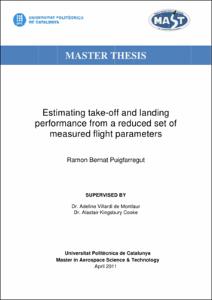Mostra el registre d'ítem simple
Estimating take-off and landing performance from a reduced set of measured flight parameters.
| dc.contributor | Villardi de Montlaur, Adeline de |
| dc.contributor.author | Bernat Puigfarregut, Ramon |
| dc.date.accessioned | 2011-05-03T09:55:41Z |
| dc.date.available | 2011-05-03T09:55:41Z |
| dc.date.issued | 2011-04-11 |
| dc.identifier.uri | http://hdl.handle.net/2099.1/11781 |
| dc.description | The main aim is to describe a series of flying qualities investigations designed to look at flying qualities issues associated with civil transport aircraft. It follows on from a previous study which considered flying qualities for the reconfiguration, approach and landing tasks. The initial issue is determining the touch-down severity from the data routinely recorded on the aircraft. If this is successful, further analysis may be conducted to look at take-off and landing rolls. The task considered for this series of evaluations meets the following reason. The performance will be only evaluated between airspeeds of 140 knots and 121 knots for the approach and then to approximately 115 knots in the flare during the previous set of evaluations. This obviously does not cover the entire aircraft airspeed range, but it is deemed a suitable task for evaluating the performance under consideration. The investigations will be focused on the next fields: - Ground effect. The extra-lift generated by the ground proximity involves a change in the aircraft behaviour. This implies an earlier lift-off and a delayed touch-down. - Take-off performance. An accurate take-off performance study is necessary in order to find the maximum CL/CD ratio during this critical phase from the machine point of view. - Undercarriage design and load limits. The undercarriage takes a special roll during the transferring phase from the contact control to the aerodynamic control and vice versa. |
| dc.description.abstract | The main aim is to describe a series of flying qualities investigations designed to look at flying qualities issues associated with civil transport aircraft. It follows on from a previous study which considered flying qualities for the reconfiguration, approach and landing tasks. The initial issue is determining the touch-down severity from the data routinely recorded on the aircraft. If this is successful, further analysis may be conducted to look at take-off and landing rolls. The task considered for this series of evaluations meets the following reason. The performance will be only evaluated between airspeeds of 140 knots and 121 knots for the approach and then to approximately 115 knots in the flare during the previous set of evaluations. This obviously does not cover the entire aircraft airspeed range, but it is deemed a suitable task for evaluating the performance under consideration. The investigations will be focused on the next fields: - Ground effect. The extra-lift generated by the ground proximity involves a change in the aircraft behaviour. This implies an earlier lift-off and a delayed touch-down. - Take-off performance. An accurate take-off performance study is necessary in order to find the maximum CL/CD ratio during this critical phase from the machine point of view. - Undercarriage design and load limits. The undercarriage takes a special roll during the transferring phase from the contact control to the aerodynamic control and vice versa. |
| dc.language.iso | eng |
| dc.publisher | Universitat Politècnica de Catalunya |
| dc.rights | Attribution-NonCommercial-ShareAlike 3.0 Spain |
| dc.rights.uri | http://creativecommons.org/licenses/by-nc-sa/3.0/es/ |
| dc.subject | Àrees temàtiques de la UPC::Aeronàutica i espai::Aeronaus |
| dc.subject.lcsh | Airplanes--Takeoff |
| dc.subject.lcsh | Airplanes Landing |
| dc.subject.other | aircraft performance |
| dc.title | Estimating take-off and landing performance from a reduced set of measured flight parameters. |
| dc.type | Master thesis |
| dc.subject.lemac | Avions |
| dc.rights.access | Open Access |
| dc.date.updated | 2011-04-13T06:07:19Z |
| dc.audience.educationlevel | Estudis de primer/segon cicle |
| dc.audience.mediator | Escola d'Enginyeria de Telecomunicació i Aeroespacial de Castelldefels |


